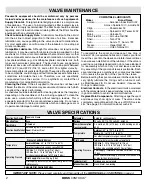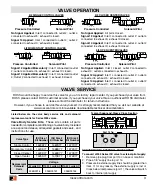
W65
Series
ISO 5599-2 Valves
Thank You!
You have purchased a premium quality ROSS
®
pneumatic
valve. It is a precision spool-and- sleeve valve designed for
mounting on a base with an ISO 5599/II interface.
With care in its installation and maintenance you can expect
it to have a long and economical service life. So before you
go any further, please take a few minutes to look over the
information in this document. Then, save it for future reference
and for the useful service information it contains.
Double
Solenoid Pilot Valve
Pressure Controlled
Valve
Pneumatic equipment should be installed only by
persons trained and experienced in such installation.
Air Lines:
Before installing a valve in a new or an
existing system, the air lines must be blown clean of all
contaminants.
It is recommended that a 5-micron-rated
air filter be installed in the inlet line close to the valve.
Valve Inlet (Port 1):
Be sure that the supply line is of
adequate size and does not restrict the air supply because
of a crimp in the line, a sharp bend, or a clogged filter
element. An inadequate air supply will adversely affect
the performance of your valve.
Valve Outlets (Ports 2 and 4):
For faster pressurizing
and exhausting of the mechanism being operated by
the valve, locate the valve as close as possible to the
mechanism. The lines must be of adequate size and be
free of crimps and sharp bends.
Valve Exhausts (Ports 3 and 5):
To reduce exhaust
noise, an efficient silencer may be used. ROSS silencers
reduce impact noise by as much as 25 dB.
Electrical Supply:
The voltage and hertz ratings of
the valve solenoids (if any) are shown on the valve.
The electrical supply must correspond to these ratings.
Otherwise the solenoids are subject to early failure. If
power is supplied by a transformer it must be capable
of handling the inrush current without significant voltage
drop. See
Valve Specifications
on page 2 for information
on inrush current.
Operating Pressures and Temperatures:
Allowable
ranges for pressure and temperature are given in the
Valve Specifications
on page 2. Exceeding the values
shown can shorten valve life.
Pilot Supply:
Pressure Control:
For valves with single remote pressure
control, connect the control line to port 14 in the sub-base
or manifold. For valves with double remote pressure
control, connect the control lines to ports 12 and 14
in the base. See
Valve Specifications
on page 2 for
required pressures.
Solenoid Control:
Pressure for pilot valves is supplied
from the inlet port. Be sure that port 14 in the base is
plugged or pilot air will escape. If the valve must operate
with an inlet pressure less than the required pilot pressure
(see
Valve Specifications
on page 2), an external pilot
supply of sufficient pressure must be provided. Connect
the external pilot supply to port 14 in the base.
Non-Air Service:
Such applications require an external
pilot supply for solenoid valves. Connect to port 14 in
the base.
Consult ROSS for fluid media other than air.
Pipe Installation:
To install pipe in valve ports, engage
pipe one turn, apply pipe thread sealant (tape not
recommended), and tighten pipe. This procedure will
prevent sealant from entering and contaminating the valve.
Single
Solenoid Pilot Valve
VALVE INSTALLATION
ROSS
CONTROLS
®
rosscontrols.com
Please read and make sure you understand all installation instructions before proceeding with the installation.
Additional technical documentation is available for download at rosscontrols.com.
If you have any questions about installation or servicing your valve, please contact ROSS or
your authorized ROSS distributor, see contact information listed at the back of this document,
or visit www.rosscontrols.com to find your distributor.





















